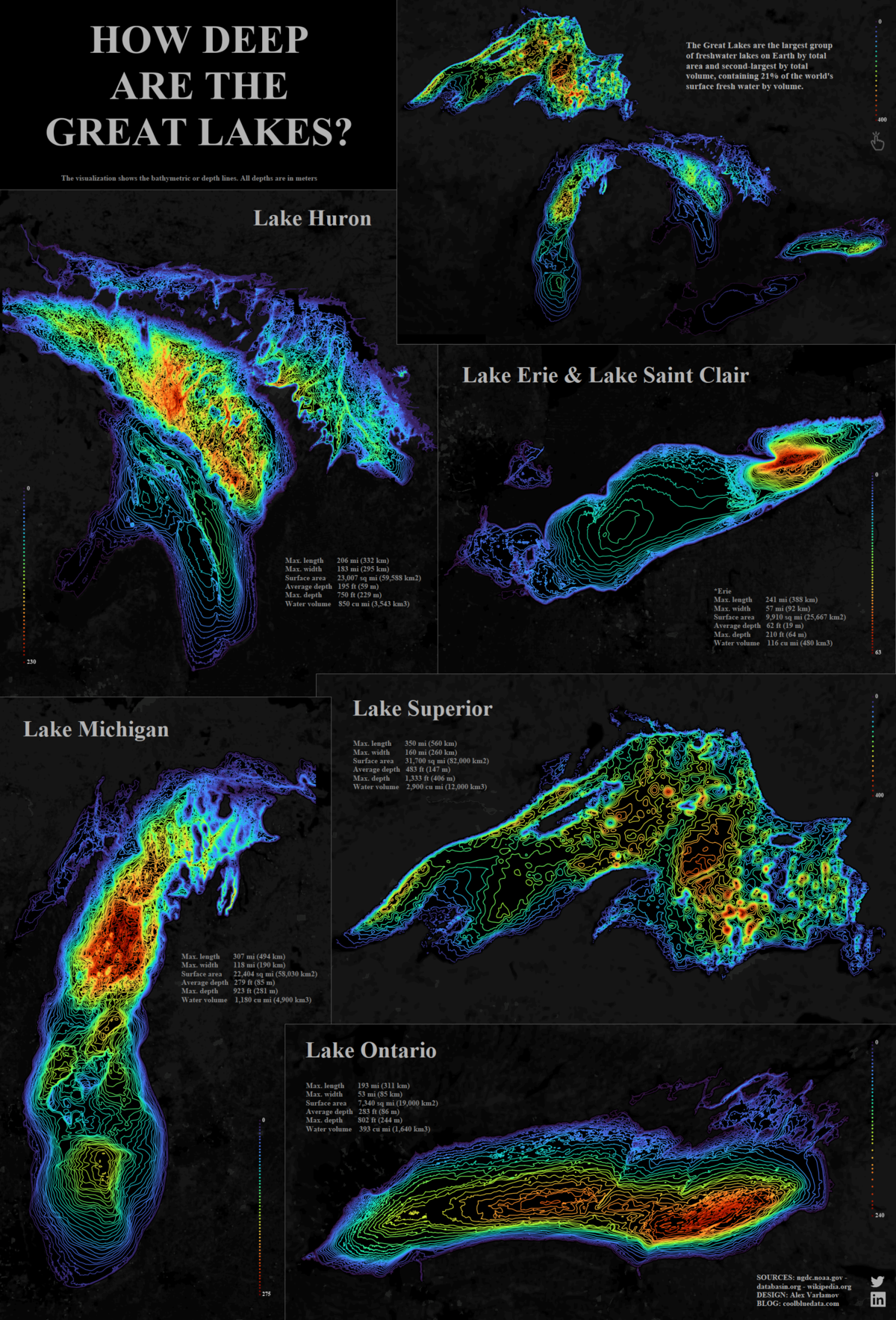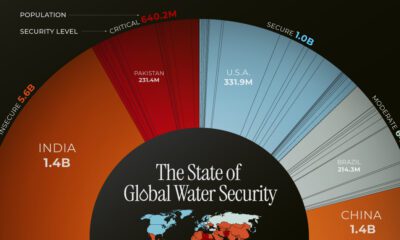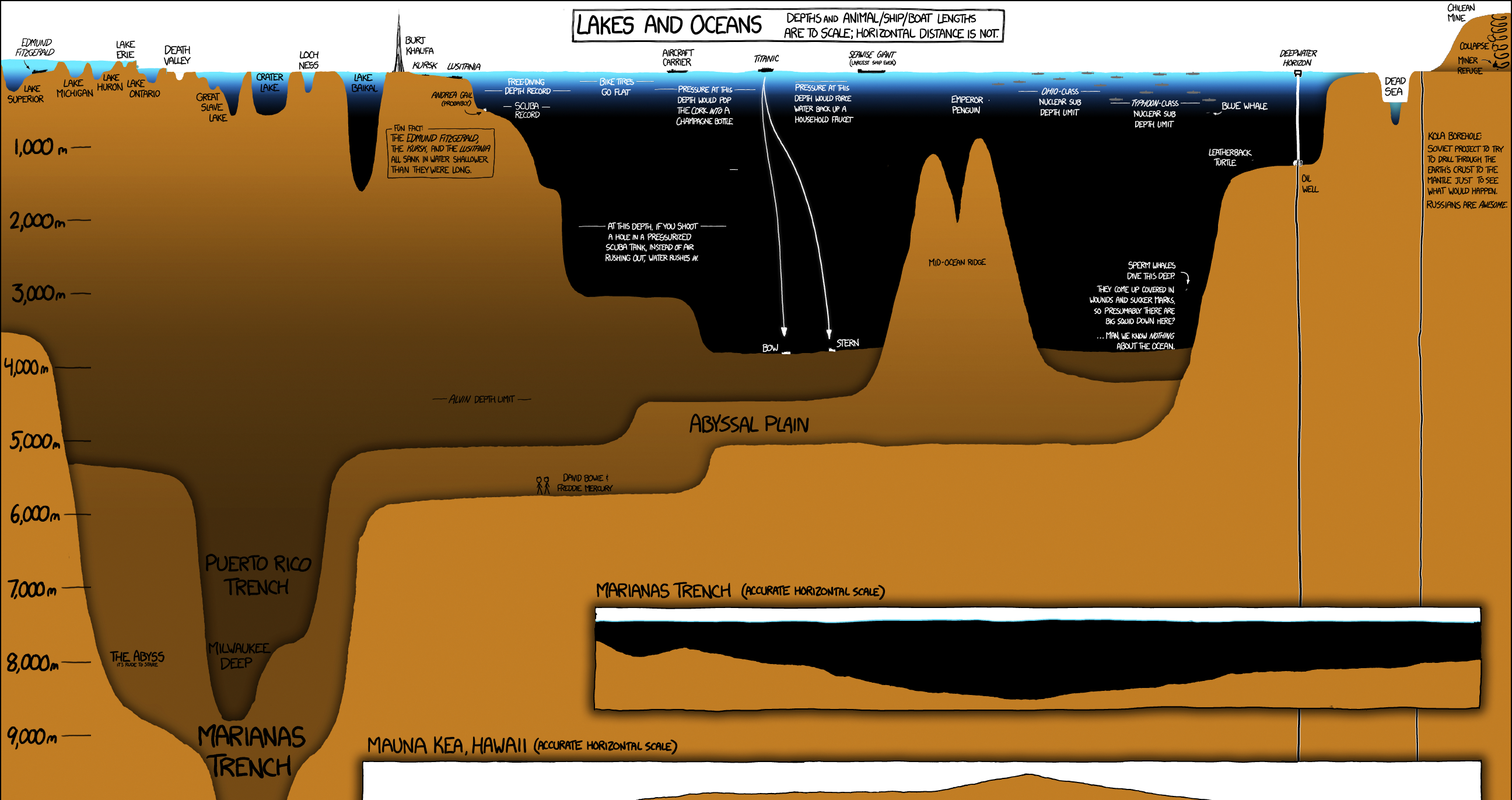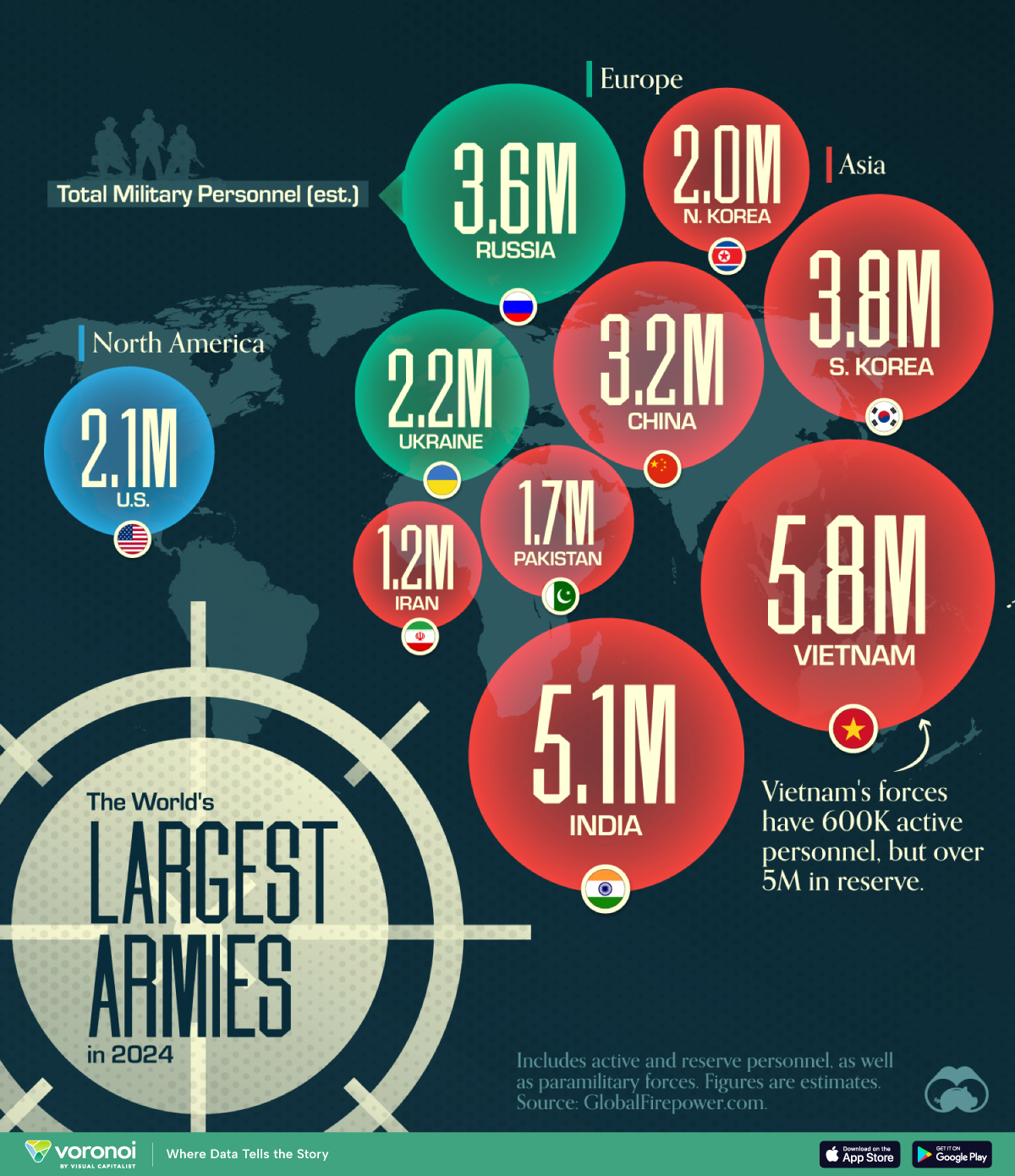Misc
Visualizing the Depth of the Great Lakes
View the full-resolution version of this infographic
Visualized: The Depth of The Great Lakes
Click here to view the interactive version of the visualization on Tableau.
As the seasons change, it’s natural to want to enjoy the outdoors to the fullest. The Great Lakes, a distinct geographical region sandwiched between the U.S. and Canada, provides immense opportunity for millions of tourists to do just that every year.
But did you know that altogether the Great Lakes contain 21% of the world’s surface freshwater by volume—or 84% of the surface freshwater in North America?
This bathymetric visualization, created by Alex Varlamov, helps put the sheer size and depth of all five of the Great Lakes into perspective.
What is Bathymetry?
Bathymetry is the study of the underwater depth of ocean or lake floors, a geographical science that falls under the wider umbrella of hydrography.
In essence, it is the underwater equivalent of topography. Contour lines help to represent and study the physical features of bodies of water, from oceans to lakes.
Most bathymetric studies are conducted via sonar systems, transmitting pulses that ‘ping’ off the ocean and lake floor, uncovering what lies below.
The Depth of the Great Lakes, Compared
High on the list of the world’s largest lakes, the five Great Lakes altogether account for over 244,700 km² (94,250 mi²) in total surface area. That’s bigger than the entire United Kingdom.
Lake Superior emerges, well, superior in terms of total surface area, water volume, and both average and maximum depth.
| Surface area | Water volume | Average depth | Maximum depth | |
|---|---|---|---|---|
| Lake Ontario | 19,000 km² (7,340 mi²) | 1,640 km³ (393 mi³) | 86 m (283 ft) | 245 m (804 ft) |
| Lake Erie | 25,700 km² (9,910 mi²) | 480 km³ (116 mi³) | 19 m (62 ft) | 64 m (210 ft) |
| Lake Michigan | 58,000 km² (22,300 mi²) | 4,900 km³ (1,180 mi³) | 85 m (279 ft) | 282 m (925 ft) |
| Lake Huron | 60,000 km² (23,000 mi²) | 3,500 km³ (850 mi³) | 59 m (195 ft) | 228 m (748 ft) |
| Lake Superior | 82,000 km² (31,700 mi²) | 12,000 km³ (2,900 mi³) | 147 m (483 ft) | 406 m (1,333 ft) |
Lake Erie is by far the shallowest of the lakes, with an average depth of just 19 meters (62 ft). That means on average, Lake Superior is about eight times deeper.
With that in mind, one drawback of the visualization is that it doesn’t provide an accurate view of how deep these lakes are in relation to one another.
For that, check out this additional visualization also created by Alex Varlamov, which is scaled to the same 20 meter step—in this view, Lake Erie practically disappears.
More than Meets the Eye
The Great Lakes are not only notable for their form, but also their function—they’re a crucial waterway contributing to the economy of the area, supporting over 50 million jobs and contributing $6 trillion to gross domestic product (GDP).
Together, the five Great Lakes feed into the Atlantic Ocean—and when we expand the scope to compare these lakes to vast oceans, trenches, and drill holes, the depth of the Great Lakes barely scratches the surface.
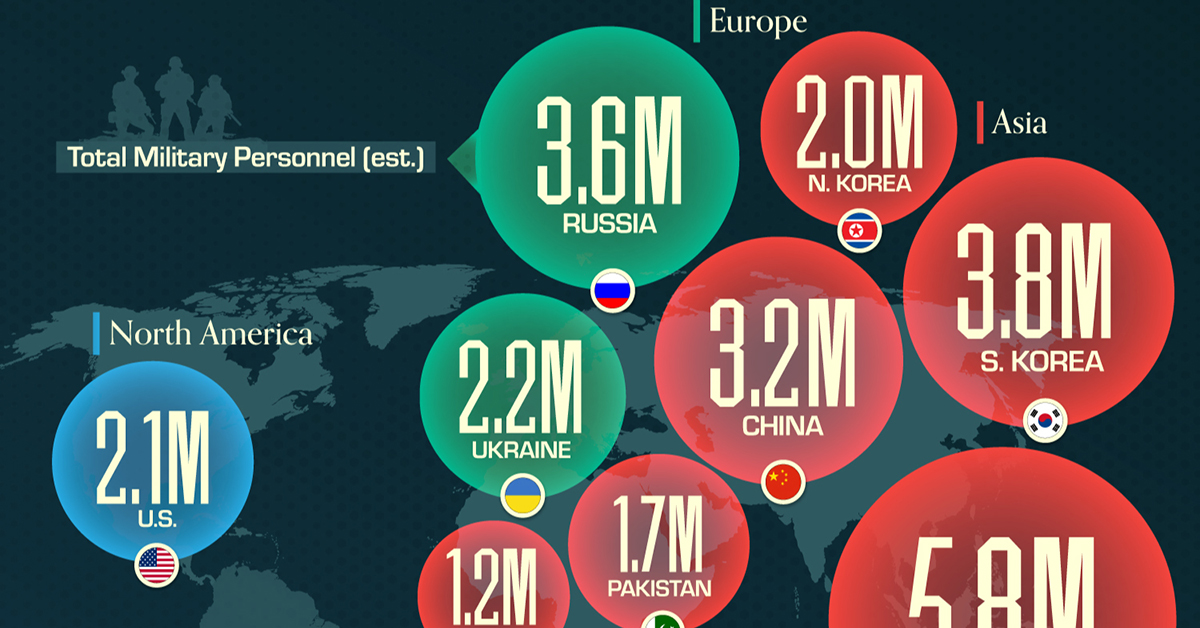
Mapped: The World’s Largest Armies in 2024
This was originally posted on our Voronoi app. Download the app for free on iOS or Android and discover incredible data-driven charts from a variety of trusted sources.
Despite being considered the biggest military force in the world, the United States doesn’t have the largest army in terms of personnel.
This graphic shows the top 10 countries by military personnel as of May 2024, including active and reserve personnel, as well as paramilitary forces. It is based on estimates from GlobalFirepower.com.
Vietnam, India, and South Korea Have the Biggest Armies
China has the largest standing army, with over 2 million active personnel. With increasing defense spending over the last decades, the country also ranks third in the number of tanks and second in the number of aircraft carriers in service.
When reserve personnel are included, however, the Chinese military falls behind those of Vietnam, India, South Korea, and Russia.
Vietnam’s forces include 600,000 active personnel and over 5 million in reserve. This is because Vietnam, along with countries like South Korea and Israel, has a standing policy of conscription for young adults.
| Country | Total Military Personnel (est.) | Region |
|---|---|---|
| 🇻🇳 Vietnam | 5.8M | Asia |
| 🇮🇳 India | 5.1M | Asia |
| 🇰🇷 South Korea | 3.8M | Asia |
| 🇷🇺 Russia | 3.6M | Europe/Asia |
| 🇨🇳 China | 3.2M | Asia |
| 🇺🇦 Ukraine | 2.2M | Europe |
| 🇺🇸 United States | 2.1M | North America |
| 🇰🇵 North Korea | 2.0M | Asia |
| 🇵🇰 Pakistan | 1.7M | Asia |
| 🇮🇷 Iran | 1.2M | Middle East |
Interestingly, the 2022 Russian invasion of Ukraine resulted in a massive increase in Ukrainian personnel numbers. Active personnel rose from around 170,000 in 2016 to over 900,000.
Despite not having the largest army, the U.S. accounts for almost 40% of global military expenditures, with its 2022 spending totaling $877 billion.
China ranked second in absolute terms, accounting for another 13% of world military expenditure at $292 billion.
-

 Healthcare1 week ago
Healthcare1 week agoVisualizing Daily Protein Sources by Region
-

 Globalization2 weeks ago
Globalization2 weeks agoMapped: The Top Exports in Asian Countries
-

 Finance2 weeks ago
Finance2 weeks agoRanked: The World’s 50 Largest Private Equity Firms
-

 United States2 weeks ago
United States2 weeks agoMapped: The 10 U.S. States With the Lowest Real GDP Growth
-

 United States2 weeks ago
United States2 weeks agoComparing New and Current U.S. Tariffs on Chinese Imports
-

 China2 weeks ago
China2 weeks agoWhich Countries Have the Most Economic Influence in Southeast Asia?
-

 Demographics2 weeks ago
Demographics2 weeks agoThe Top 25 Nationalities of U.S. Immigrants
-

 Countries2 weeks ago
Countries2 weeks agoRanked: Countries Where Youth are the Most Unhappy, Relative to Older Generations

